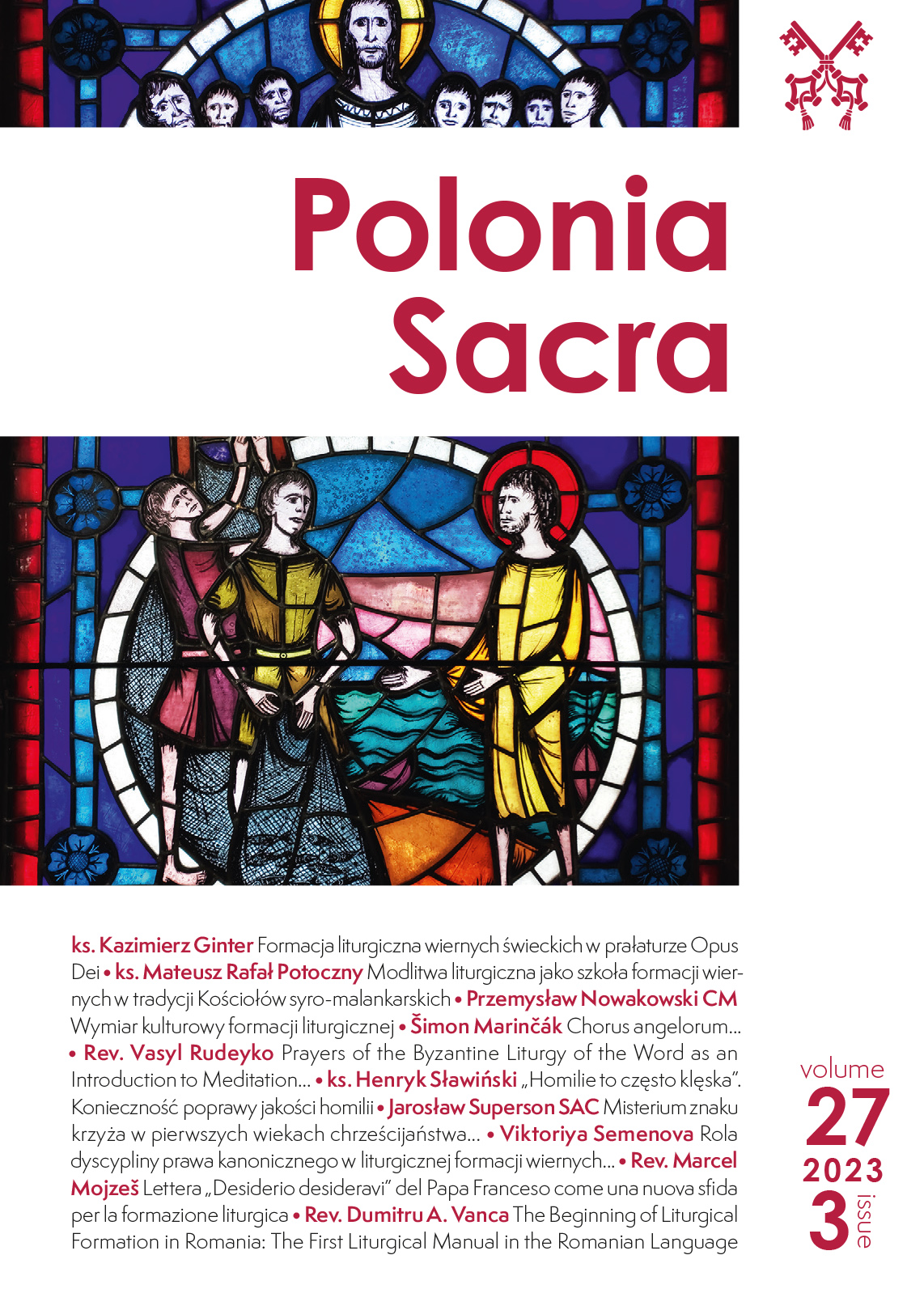The Cultural Dimension of Liturgical Formation
DOI:
https://doi.org/10.15633/ps.27303Keywords:
liturgy, worship, culture, inculturation, liturgical formationAbstract
The author of the article undertakes a reflection upon the issue of renewal and vivification of the traditional relation of liturgy and culture, whose condition seems to be an appropriate liturgical formation of the contemporary faithful. Liturgy understood as worship of God performed by people is a part of human culture. Liturgy is a special example of the Christian inculturation, lasting continuously within the history. Today this process requires considering new challenges facing the crisis of modern culture, which has loosen its bond with religion. A contemporary man has lost the ability to comprehend the symbolic language of liturgy. Therefore the Pope Francis in his Letter Desiderio desideravi indicates a need of deepened liturgical formation of the faithful. Such formation, that will let the faithful grasp the timeless message of liturgy, will also unable them to shape it by applying new cultural codes. In this sense liturgical formation may play an important role in regaining connection of culture and liturgy, so that liturgy could still form and enrich culture, at the same time drawing from its heritage.
References
Bonomo F., Presentazione, w: Liturgia e Cultura. Atti dell’XI Congressio Internazionale di Liturgia, Pontificio Ateneo sant’Anselmo — Pontificio Istituto Liturgico, 9–11 maggio 2018, a cura di F. Bonomo, S. Geiger, D. Jurczak, F. M. T. Ryan, Roma 2019, s. 29–37 (Ecclesia orans. Studi e Ricerche, 2).
Cassingena-Trévedy F., La bellezza della liturgia, Magnano 2003.
Florenski P., Liturgia jako synteza sztuk, „Znak” 337 (1982), s. 1511–1521.
Franciszek, Adhortacja apostolska Evangelii gaudium, 24.11.2013, Rzym 2013.
Franciszek, List apostolski Desiderio desideravi, 29.06.2022, Rzym 2022.
Giovanni Paolo II, Messaggio all’Assamblea Generale delle Nazioni Unite per la celebrazione del 50 universario di fondazione, 05.10.1995.
Guardini R., Liturgische bildung (1928), w: R. Guardini, Liturgie und liturgische bildung, Mainz 1992.
Harrisadis C., Le cult chrétien. Facteur de développement et de civilisation, w: Liturgie. Spiritualité. Cultures, Conferences Saint-Serge, XXIX Semaine d’Etudes Liturgiques, Paris, 29 juin — 2 juillet 1982, a cura di A. M. Triacca, A. Pistoia, Roma 1983, s. 115–131 (Bibliotheca Ephemerides Liturgicae. Subsidia, 20).
Jan Paweł II, Encyklika Slavorum apostoli, Poznań 1985.
Leksykon liturgii, oprac. B. Nadolski, Poznań 2006.
Ravasi G., La liturgia tra lumen e numen. Culto e cultura, w: Liturgia e Cultura. Atti dell’XI Congresso Internazionale di Liturgia, Pontificio Ateneo sant’Anselmo — Pontificio Istituto Liturgico, Roma 9–11 maggio 2018, a cura di F. Bonomo, S. Geiger, D. Jurczak, F. M. T. Ryan, Roma 2019, s. 43–56 (Ecclesia orans. Studi e Ricerche, 2).
Sante di C., Cultura e liturgia, w: Nuovo Dizionario di Liturgia, Cinisello Balsamo (Milano) 1988, s. 325–326.
Sobór Watykański II, Konstytucja o liturgii świętej Sacrosanctum Concilium, Rzym 1963.
Downloads
Published
Issue
Section
License
Copyright (c) 2023 Przemysław Nowakowski

This work is licensed under a Creative Commons Attribution 4.0 International License.
Authors who publish in this journal agree to the following terms:
- Authors retain the copyright and full publishing rights without restrictions and grant the journal right of first publication with the work simultaneously licensed under a Creative Commons Attribution 4.0 International License that allows others to share the work with an acknowledgement of the work's authorship and initial publication in this journal.
- Authors are able to enter into separate, additional contractual arrangements for the non-exclusive distribution of the journal's published version of the work (e.g., post it to an institutional repository or publish it in a book), with an acknowledgement of its initial publication in this journal.
- Authors are permitted and encouraged to post their work online (e.g., in institutional repositories or on their website) prior to and during the submission process, as this can lead to productive exchanges, as well as earlier and greater citation of published work (See The Effect of Open Access).

